Today after breakfast we packed our backpacks for a day in the field down the river. The objective was to survey another area to mount sap flow sensors on shrubs for comparison with our low and high density forest sites near the science station. The area we had in mind is on a massive floodplain. The landscape there is totally different. There are not as many trees, it’s very flat, very wet with a fair number of shrubs and a lot of tussocks. Tussocks are these very large and dense clumps of thick grass. They are extremely difficult to navigate when walking through a field of them. Imagine trying to walk through a field of grass covered basketballs. It may seem easy to just walk on top of them, but they are wildly unstable and it can be even more difficult to walk in the trenches between them. The trenches are where they are the wettest and they can be knee deep in spots. Not easy. So that’s where we chose our spot. A shrub-filled tussock field.
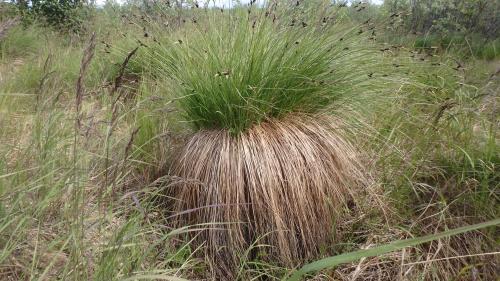 Tussock!
Tussock!
The new area is a 30-minute boat ride from the Northeast Science Station in Cherskiy. We worked with one of the stations main employees named Valodya. We met him down by the barge where he was fueling up his small boat that will transport us. We loaded our gear and equipment on the boat, put on our life vests and headed northwest downstream from the station. The new site is located on a tributary off of the Panteleha River right in the midst of the floodplain itself. After a smooth ride with some beautiful scenery we arrived at the site. Valodya docks by driving the boat into the shallow edge and up onto the bank, jumps out and ties us off as his dog comes to meet him. On the bank is a shipping container with a small cabin above it where Valodya stays for the summer season. He is the caretaker of this particular site. On the grounds is a large tank-like vehicle that houses a large generator. The generator is used to run a Eddy Covariance tower that was constructed by a team of German research scientists from the Max Plank Institute for Biogeochemistry in Germany. They come to Cherskiy every season for research and should arrive sometime next week.
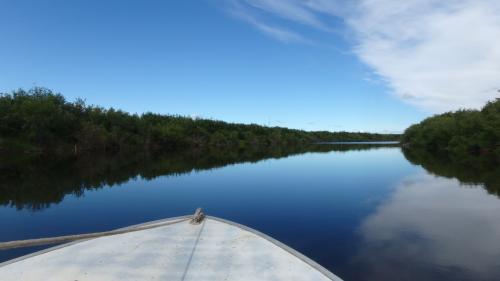 Morning commute down the river to our field site
Morning commute down the river to our field site
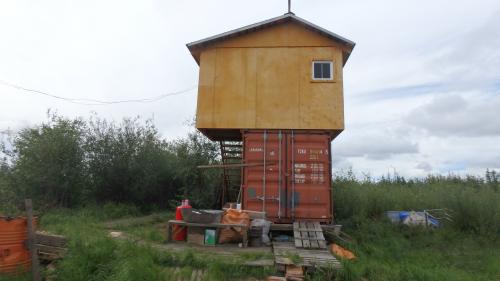 Field cabin and storage facility at the research site
Field cabin and storage facility at the research site
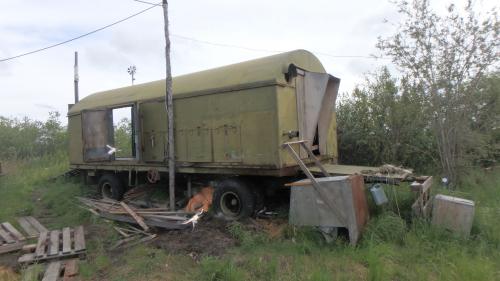 Old trailer used to houses the generator needed for the Eddy covariance tower
Old trailer used to houses the generator needed for the Eddy covariance tower
Since this site is mainly wet and filled with tussocks, a boardwalk was created along with small wooden towers to hold up the heavy line of cables coming from the generator. The tower is similar to what Mike Loranty and I set up in the low and high density forest sites discussed in a previous journal. It is used to measure the amount of energy moving in an out of the system, but also is used to measure gas concentrations at different level around the tower.
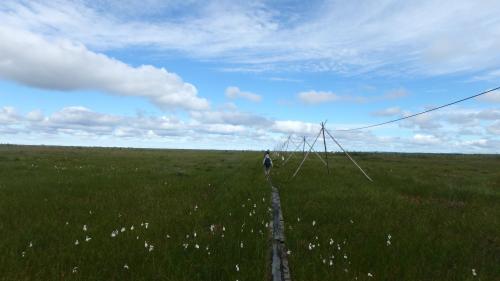 Walking down the boardwalk along the heavy string of cables to the Eddy Covariance tower.
Walking down the boardwalk along the heavy string of cables to the Eddy Covariance tower.
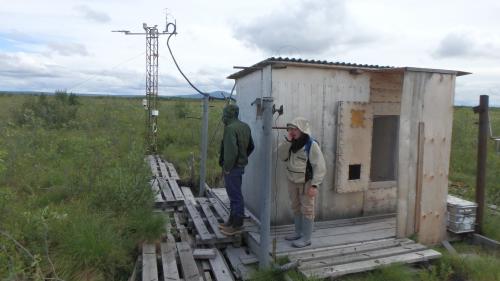 Mike Loranty and Heather Kropp checking out the Eddy Covariance tower
Mike Loranty and Heather Kropp checking out the Eddy Covariance tower
For our sap flow shrub study we are working well away from the tower to ensure our equipment doesn’t interfere with their work. Our new spot has shrubs similar in species to that of our comparison site, but also offers other species and are much taller, due to the increased amount of water. The variations in size and species allow us to make a connection to the environmental differences we are seeing here. We spent the morning wiring up the logger boxes, solar panel backups, and placed all of the sensors on shrubs of three different species. We will be back throughout the week to check up on the system and download the data.
As we headed back to lunch we chatted with Valodya about the river and surrounding environment. Valodya commutes up the river every morning to work at the science station and tries to describe in Russian and hand movements how he sees moose along the banks of the river on a regular basis. Apparently they wade in the water up to their neck to avoid the onslaught of mosquitos as well. I had my camera ready, but no luck today. We saw many fish jumping along the way and the fisherman in me wanted to slow down and toss a line in the water. The Arctic terns were flying around dive bombing the water for fish and we even passed a fishing hut with a friendly face waving to us as he shook out his net.
What a great day exploring this area of Russia by boat.
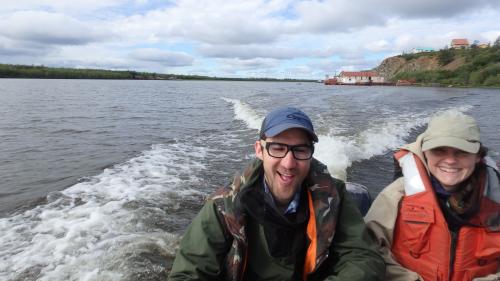 Mike Loranty and Heather Kropp enjoying the boat ride to our field site today.
Mike Loranty and Heather Kropp enjoying the boat ride to our field site today.
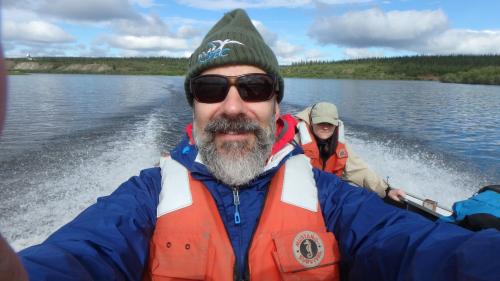 Stan Skotnicki happy to be part of this incredible expedition in Cherskiy, Russia
Stan Skotnicki happy to be part of this incredible expedition in Cherskiy, Russia

Comments